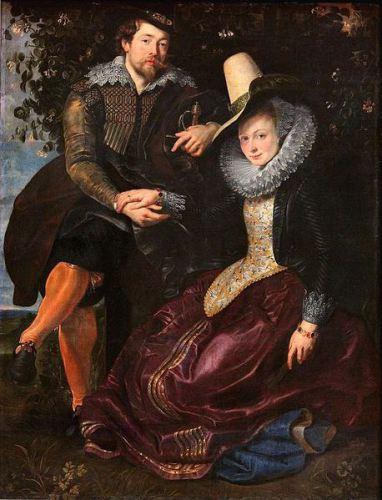
The Artist and His First Wife, Isabella Brant, in the Honeysuckle Bower, Rubens, c1609. Photo: Alte Pinakothek, Munich. (Not in the exhibition!)
It sometimes comes as something of a surprise to people when they find out that I have a degree in History of Art. I’m not entirely sure why that is but suspect that it’s down to a combination of this blog being more weighted towards the history side of things and also my own demeanour being somewhat unlike that of the stereotypical Art History graduate, which I suppose is understandable as I didn’t really fit in with my undergraduate peers either.
Although I love few things better than trolling people by pretending to hate art so that they start frothing in defence of Turner or whatever, the simple truth is that actually I really bloody love art and, given the choice, would much rather spend my time wandering around art galleries than, well, most other things that I could plausibly be doing fully dressed in a metropolitan area.
However, despite this love of art, I have to admit that a proper appreciation of the genius that was Rubens has always somehow eluded me. The main reason for this is probably down to associating him with a particularly dreadful History of Art teacher that I had for A Level, who was completely OBSESSED with Rubens to the exclusion of pretty much all other artists. This, and other issues, led to an inevitable clash between us and resulted in my being asked to leave (okay, I was summarily kicked off) my A Level course at the start of my second year at sixth form. I got the last laugh though when I still managed to get a B in my final (paid for by myself) exams and without a single reference to Rubens either. So there. (It all went wrong though when I went off to do History of Art at university and found myself confronted with three looooong years of yup, you guessed it…)
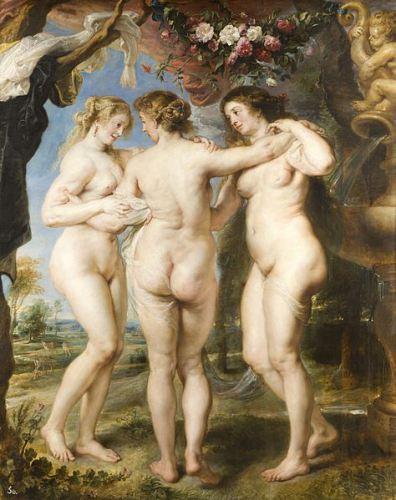
The Three Graces, Rubens, 1635. Photo: Prado. (Not in the exhibition!)
The other reason for my long term antipathy to Rubens is simple dislike – I love the austere clean lines of David, Ingres and their ilk and so just can’t get behind all the rippling, dimpled pink flesh, rolling eyes, pouting lips and chubby cupids that litter Rubens’ masterpieces. It’s all just too way over the top, too flashy and, I suppose, far too fleshily sensuous for me and my more austere neo-classical tastes.
It was some slight trepidation therefore that I accepted the Royal Academy’s invitation to spend an evening hanging out at a special blogger’s event to showcase their current exhibition, Rubens and His Legacy. However, I’m a big girl now and sixth form and its myriad of horrors was a long time ago so surely I could handle it? Well, it turns out that I could. Clearly I just need to approach Rubens in the correct environment – in this case with some extremely excellent company (the VERY lovely Jai’me of Boy Meets Fashion) and after a couple of fortifying glasses of wine in the rather swanky Academian’s Room of the Royal Academy, where we were treated to a really enthusiastic talk by a resident Rubens expert, which was so enthusiastic and vivid in fact that I was RARING to get into the galleries and see the paintings for myself. Unfortunately, I don’t think I impressed the Resident Rubens Expert quite so much as I was full of nerves and regaled him with some rather choice and hideous anecdotes about my misspent youth as an Art History undergraduate when actually I had MEANT to sound all arty and well informed and sophisticated. I suck.
ANYWAY. As it turned out, the Rubens exhibition at the Royal Academy is probably perfect for people who don’t like Rubens very much as actually there’s not that many of his own actual paintings in it. The clue is, I suppose, in the exhibition’s title – Rubens and his Legacy and indeed, the focus here is more upon the artists that came after him and his influence upon them than his own lengthy and glorious career. However, the pieces that they DO have on display are pretty choice examples of his genius and perfectly showcase why he is still revered so much today, long after his own heyday in the early seventeenth century.
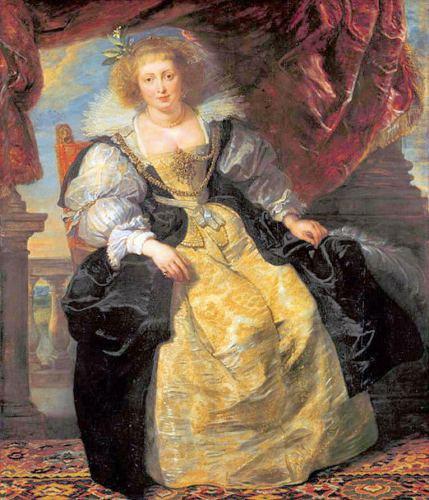
Hélène Fourment in her Wedding Dress, Rubens, c1630. Photo: Alte Pinakothek, Munich. (Not in the exhibition!)
‘One of the most prolific and sought after artists of his day, Rubens had an international list of patrons that included members of some of the most important royal families in Europe, the aristocracy and the Church. With an in-depth knowledge of Renaissance art, Rubens drew on his studies of the Italian Masters to develop his own style of lively realism and rich brushwork, creating monumental and dynamic paintings. His great versatility and immense capacity to produce work meant that his creative output encompassed every genre of painting: altarpieces, family portraits, landscapes and historical and mythological scenes. Whilst Rubens is most renowned for the depiction of his fleshy, sensuous ‘Rubenesque’ womb, the exhibition will illustrate the breadth of his accomplishment and present a artist whose visual language, from composition to theme, style and colour, impacted on artists at the time and has had continued resonance for artists throughout the centuries following his death.
Rubens and his Legacy is presented through six themes: Poetry, Elegance, Power, Lust, Compassion and Violence. Each theme links the works of Rubens to subsequent generations of great artists; starting with his assistant Van Dyck and ranging from Boucher and Watteau in the eighteenth century; Delacroix, Constable, Manet and Daumier in the nineteenth; to Cézanne and Picasso 300 years after the Flemish master’s death.’
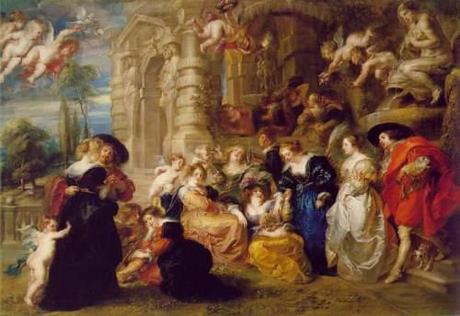
The Garden of Love, Rubens, c1635. Photo: Prado.
As I walked through the different rooms, I drank in what was ultimately a veritable riot of colour, emotion and movement and, I think, finally warmed after all these years to Rubens and what he was trying to achieve. Perhaps I had no time for such vibrant, chaotic, zesty painting in my pallid, gothic youth but I feel warmed and invigorated by it now as the very over the top-ness which I had once so despised, now actually suits my more mature and confident mood. I found myself entranced by beautiful, golden sunlit landscapes in the first room and intrigued by Rubens’ clear influence on the likes of Constable and Gainsborough, both of whom also evoked something of the divine in the natural world and subtly hinted at the great mysteries that lie behind the everyday world that we all inhabit.
The next few rooms were devoted to portraits, my most favourite form of art, and here we found a true feast for the eyes in a series of opulent, mostly full length ‘swagger’ portraits of the wealthy, powerful and good. Rubens’ clear love of sumptuous fabrics, gleaming pearls and soft, tactile furs is actually a joy to behold, not a chore, and his legacy can be seen in a wealth of artists like Gainsborough, Fragonard, Reynolds, Lawrence and Van Dyck. There’s a simplicity too in his portraits, a proper sense of the skull beneath the skin and the true personality that lies behind the eyes – no matter how dazzling his sitters appear at first glance, their faces are always absolutely individual and replete with abundant emotion. There’s a simplicity too in this raw honesty, which was to influence other artists, like Élisabeth Vigée-Lebrun, whose famously candid self portrait in a straw hat is on display here and was directly influenced by a Rubens portrait.
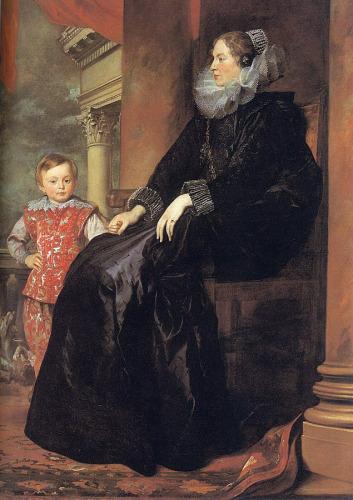
A Genoese Noblewoman with her Son, Van Dyck, c1626. Photo: National Gallery of Art, Washington.
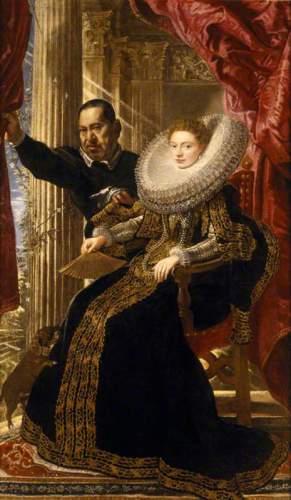
Marchesa Maria Grimaldi, and Her Dwarf, Rubens, c1607. Photo: Kingston Lacey/National Trust.
I really loved the contrast between Rubens’ wonderful portrait, Marchesa Maria Grimaldi and her Dwarf and its neighbour, the rather awkwardly compositioned A Genoese Noblewoman and her Son by his pupil, Van Dyck. The main draw of the first painting is the gorgeous Marchesa’s almost saucy expression as she gazes out of the canvas with the faint hint of a smile, while her dwarf companion glowers almost angrily at the viewer as if he doesn’t want to be painted. This work is alive with shimmering emotion and charm, whereas the Van Dyck beside it has a rather more sombre and even sad atmosphere as the noblewoman, who is painted in profile gazes stonily away from both the viewer and her young son, their bond reinforced only by the fact that they are holding hands. Not that the little boy seems to care very much – he has all the trademark swagger of a young Van Dyck nobleman even at a clearly tender age. I bet he would have much more fun in the Marchesa’s lively canvas though.
There follows the sort of lavish, rollicking paintings that are perhaps more usually associated with Rubens and in particular his celebrated The Garden of Love, which depicts courting couples in a fantastical and fanciful landscape, being forced together by plumply mischievous cupids. As we noted as we stood before it, although the title refers to ‘love’, there is very little that is actually romantic about this work – after all, the cupids are the ones doing all the work here, while the couples themselves seem rather uninterested in each other. There’s a sense too that it is the women that hold all the power in the Garden of Love – they dominate the scene and seem bored by the attempts of the men to get their attention.
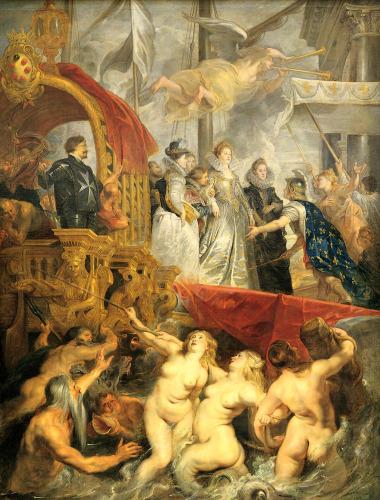
The Disembarkation at Marseilles (part of the Marie de Medici cycle), Rubens, c1623. Photo: Musée Louvre.
We also paused for a while to admire a projection of Rubens’ amazing series of paintings about the life of Marie de Medici, Queen of France, who is a bit of a favourite of mine even though she was deeply unpopular with her own people. A difficult and rather larger than life personality, she made a perfect candidate for Rubens’ brush though, epitomising as she did the extraordinary powerful individuals who dominated the political arena during his lifetime. Rubens’ lavish series of paintings about the Queen are an absolute masterpiece (they feature in my fourth novel when Henrietta Maria of England, who was the daughter of Marie de Medici and Henri IV of France takes her daughter to see them in the Palais du Luxembourg) and are intended as an elaborate exercise of self promotion, designed to enhance the unpopular Queen’s prestige. It makes me think that if Rubens were alive today, he might well have eschewed the art world for that of advertising instead as he was all about the bold colours, the eye catching gestures, the adoration of excess and the triumph of style over substance.
The other rooms are similarly replete with fabulous works of art as we moved through the other themes of compassion and violence, which had a rather more religious theme than those in the preceding rooms. Although Rubens is probably best known for the whole ‘Rubenesque’ thing, I actually find his overall painting style extremely masculine – probably because it’s so bold and un-compromising and nowhere can this be seen more than in his rightfully celebated work, The Tiger Hunt, which immediately brings to mind Leonardo da Vinci’s lost masterpiece, The Battle of Anghiari. I am a bit of an animal lover so I have to say that my sympathies in this work are entirely with the unfortunate big cats and not the men who have hunted them down. However, although I find this piece uncomfortable to look at, it’s still hard to tear your eyes away from the whirl of frenzied activity going on before you and, like all the best things in life, the enthusiasm of its creator really shines through. You can really imagine Rubens stepping away from this monumental canvas, putting down his brush and saying to himself with enormous satisfaction: ‘Yup, that’s good.’
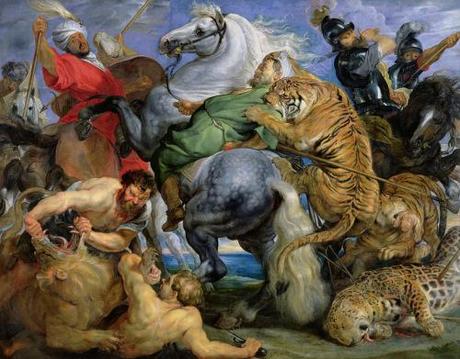
The Tiger Hunt, Rubens, c1616. Photo: Musée des Beaux Arts, Rennes.
Rubens and his Legacy is sponsored by BNY Mellon and is on at the Royal Academy of Arts until the 10th of April. Full price adult tickets are £16.50, with concessions available.
Many thanks to the Royal Academy of Arts press team for the invitation!
******
Set against the infamous Jack the Ripper murders of autumn 1888 and based on the author’s own family history, From Whitechapel is a dark and sumptuous tale of bittersweet love, friendship, loss and redemption and is available NOW from Amazon UK, Amazon US and Burning Eye.
‘Frothy, light hearted, gorgeous. The perfect summer read.’ Minette, my young adult novel of 17th century posh doom and intrigue is available from Amazon UK and Amazon US and is CHEAP AS CHIPS as we like to say in dear old Blighty.
Follow my blog with Bloglovin
Follow me on Instagram.
Follow me on Facebook.
Follow me on Twitter.
